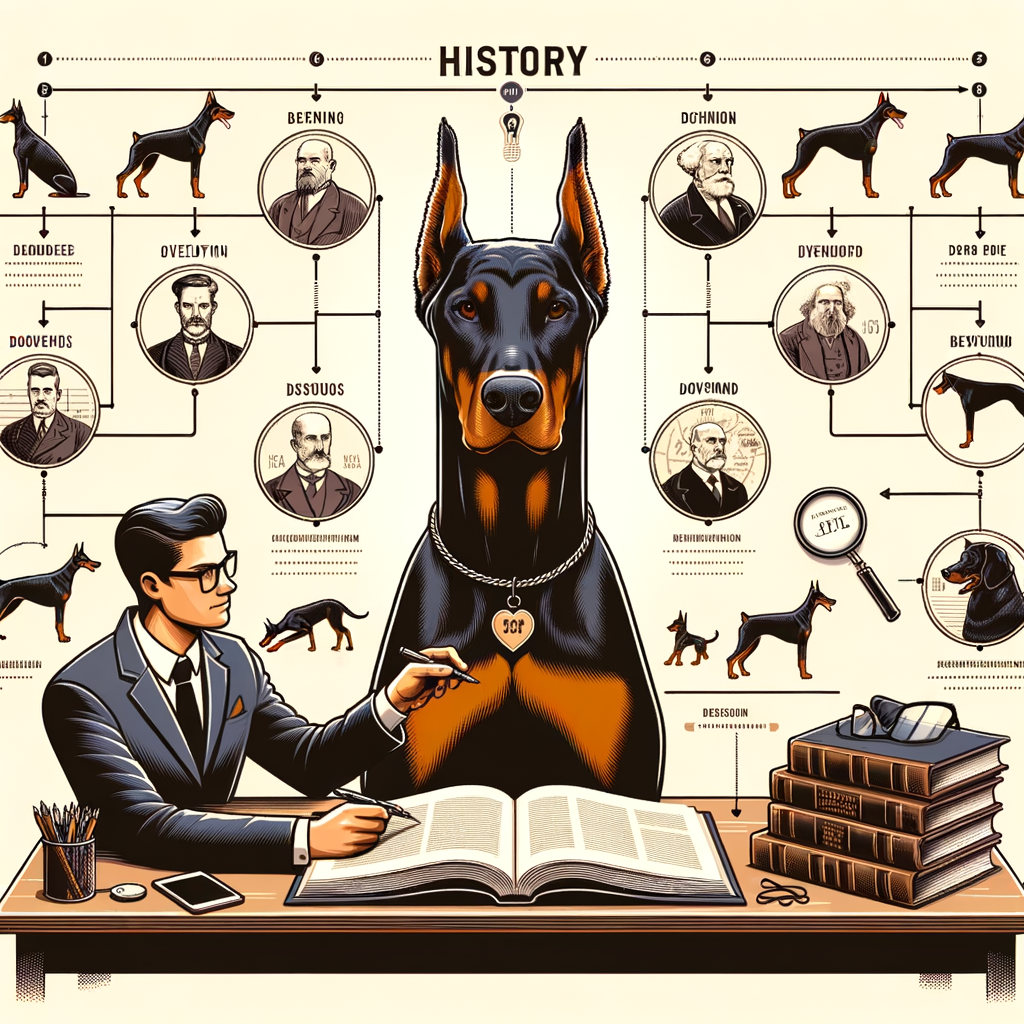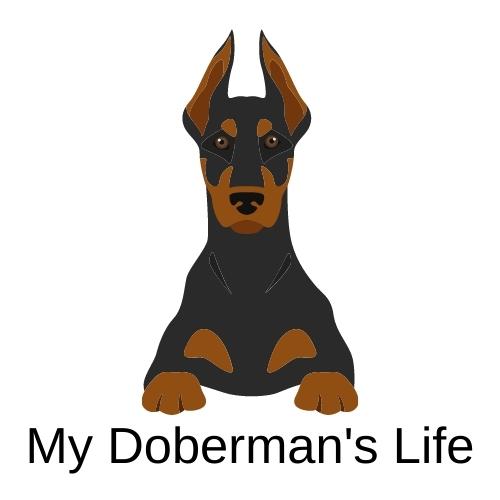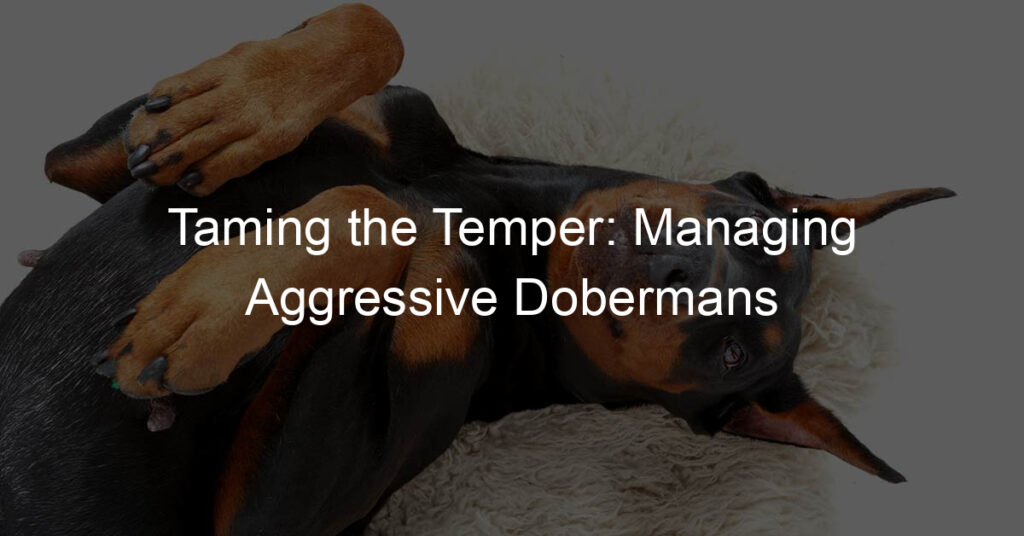
Introduction to Doberman Breed History
Welcome to our comprehensive guide about the Doberman breed. This article will provide you with an overview of the breed and explain why understanding its history is crucial.
-
Overview of the Doberman Breed
The Doberman is a breed of domestic dog originally developed around 1890 by Karl Friedrich Louis Dobermann, a tax collector from Germany. Dobermans are known for their loyalty, intelligence, and strong protective instincts. They are often used as police dogs, guard dogs, and search and rescue dogs. They are medium-large in size, with a sleek coat and athletic build.
-
Importance of Understanding Doberman Breed History
Understanding the history of the Doberman breed is crucial for several reasons. Firstly, it provides insight into the breed’s temperament and behavior. The Doberman was bred to be protective, which is why they are often used in roles that require a high level of alertness and courage. Secondly, knowing the breed’s history can help owners and breeders maintain the health and longevity of the breed. By understanding the health issues that Dobermans have faced in the past, we can take steps to prevent them in the future.
In the following sections, we will delve deeper into the history of the Doberman breed, explore case studies, and conclude with a summary of the breed’s journey. Stay tuned to learn more about this fascinating breed.
Deep Dive into Doberman History
Let’s take a closer look at the fascinating history of the Doberman breed. We’ll start from the very beginning, exploring their roots and the key figures who played a role in their development.
Origins of the Doberman Breed
The Doberman breed has a rich and intriguing history. It’s a tale that takes us back to Germany in the late 19th century.
- Doberman’s roots in Germany
- Role of Louis Dobermann in Doberman breed development
The Doberman breed was born in Germany, a country known for its love of dogs and its history of breeding high-quality canine companions. The breed was developed in the 1890s, a time when Germany was undergoing significant changes. The industrial revolution was in full swing, and there was a growing need for a dog breed that could serve as a loyal protector and companion.
The man behind the creation of the Doberman breed was a German tax collector named Louis Dobermann. Louis needed a dog that was intelligent, loyal, and protective to accompany him on his rounds. He started breeding dogs with these traits, and the result was the Doberman breed we know today. Louis’s work in developing this breed was so significant that the breed was named after him. The Doberman breed is a testament to Louis Dobermann’s vision and dedication.
Understanding the origins of the Doberman breed gives us a deeper appreciation for these intelligent and loyal dogs. It’s a story of innovation, dedication, and a deep love for dogs. The Doberman breed’s history is a testament to the power of selective breeding and the impact one person can have on the development of a breed.
Evolution of Doberman Breed
The Doberman breed has undergone significant changes since its inception in the late 19th century. These changes are not only visible in their physical characteristics but also in their purpose and use. Let’s explore these transformations in detail.
- Changes in physical characteristics over time
- Shifts in breed purpose and use
Dobermans of the past were larger, heavier, and had a more robust appearance compared to today’s sleek and elegant Dobermans. The breed was initially developed for protection and thus, had a more intimidating look. Over time, breeders started focusing on creating a more balanced, agile, and aesthetically pleasing dog.
One of the most notable changes in the breed’s physical characteristics is the reduction in size. The average weight of a male Doberman in the 1890s was around 45-50 kg, while today, it is between 34-45 kg. Similarly, the height has also decreased from an average of 70 cm to around 65 cm.
Other changes include a more refined head, less pronounced stop, and a more elegant neck. The ears and tail, which were traditionally cropped and docked for protective purposes, are now often left natural, especially in countries where these practices are banned.
The Doberman breed was initially developed by a German tax collector named Louis Dobermann for protection. The breed was a mix of several dogs, including the Rottweiler, German Pinscher, Greyhound, and Weimaraner, to create a loyal, intelligent, and protective dog.
Over time, the use of Dobermans has shifted from being primarily guard dogs to versatile working dogs. Today, they are used in various fields such as police and military work, search and rescue, therapy, and service work. They are also popular as family pets due to their loyalty, intelligence, and trainability.
Despite these shifts in purpose and use, the Doberman breed has retained its protective instincts. They are still known for their loyalty and protective nature, making them excellent family protectors.
In conclusion, the evolution of the Doberman breed over time reflects the changing needs and preferences of society. While they have become more refined and versatile, they have retained their core characteristics of loyalty, intelligence, and protectiveness.
Understanding Doberman Breed History
The history of the Doberman breed is a fascinating tale of careful selection and breeding. This section will delve into the ancestry of the Doberman, highlighting the key breeds that contributed to its lineage and how this ancestry impacts the traits of the Doberman breed today.
Doberman Breed Ancestry
Understanding the ancestry of the Doberman breed is crucial to appreciating its unique characteristics and traits. Let’s explore this in detail.
- Key breeds contributing to Doberman’s lineage
- Impact of ancestry on Doberman’s traits
The Doberman breed is a result of a mix of several different breeds. The primary contributors include the Rottweiler, German Pinscher, Greyhound, and Weimaraner. Each of these breeds brought unique traits to the Doberman, shaping its physical appearance and temperament.
| Breed | Contributed Traits |
|---|---|
| Rottweiler | Strength, endurance, and loyalty |
| German Pinscher | Agility and alertness |
| Greyhound | Speed and slender physique |
| Weimaraner | Tracking ability and intelligence |
The Doberman’s ancestry has a significant impact on its traits. The strength and endurance from the Rottweiler, combined with the agility and alertness of the German Pinscher, make the Doberman a highly capable working dog. The speed of the Greyhound and the tracking ability of the Weimaraner have contributed to the Doberman’s role as a police and military dog. Furthermore, these ancestral traits have also made the Doberman an excellent family pet, known for its loyalty and intelligence.
In conclusion, the Doberman breed’s rich ancestry has played a significant role in shaping its unique characteristics and abilities. The careful selection and breeding of key contributing breeds have resulted in a dog that is not only physically impressive but also highly intelligent and loyal.
Doberman Breed Background
The Doberman breed has a rich and fascinating history, playing significant roles in various aspects of society. Let’s delve into the key aspects of the Doberman’s background, focusing on their involvement in the World Wars and their transition into family and service roles.
- Doberman’s role in World Wars
- Doberman’s transition into family and service roles
The Doberman breed was extensively used during the World Wars, particularly World War II. Their intelligence, agility, and loyalty made them ideal for various roles such as scouts, messengers, and guard dogs. They were known for their bravery and dedication, often risking their lives to protect their human counterparts.
One notable Doberman was a dog named Kurt, who served in the Battle of Guam in 1944. Kurt was the first to alert his human comrades of an approaching enemy, saving many lives but tragically losing his own in the process. His bravery is commemorated in the Doberman Pinscher War Dog Memorial in Guam.
Post World Wars, the Doberman breed transitioned into more peaceful roles. Their intelligence and trainability made them excellent family pets and service dogs. They are known for their protective nature, making them great guardians for families. They are also used in search and rescue operations, therapy roles, and as guide dogs for the visually impaired.
Despite their tough exterior and history as war dogs, Dobermans are known to be affectionate and gentle with their families. They are also highly adaptable, able to thrive in various living conditions, from spacious country homes to compact city apartments.
In conclusion, the Doberman breed has a diverse and intriguing background. From their heroic contributions during the World Wars to their current roles as family pets and service dogs, Dobermans continue to leave a significant mark in history.
Case Studies in Doberman Breed History
As we delve into the rich history of the Doberman breed, it’s fascinating to discover some notable Dobermans that have left an indelible mark in various fields. Let’s explore these remarkable dogs and their contributions.
Notable Dobermans in History
- Dobermans in the military
- Famous Dobermans in popular culture
Dobermans have a long history of service in the military. Their intelligence, loyalty, and physical prowess made them ideal for various roles, including scouts, sentries, and messengers.
One of the most famous military Dobermans was a dog named Kurt, who served in World War II. Kurt was the first canine casualty in the Battle of Guam in 1944. He alerted his handlers to the presence of approaching Japanese troops, saving many lives but sacrificing his own in the process. To honor Kurt and other Dobermans who served, a bronze statue was erected in Guam, known as the “Always Faithful” monument.
Dobermans have also made their mark in popular culture, appearing in movies, TV shows, and even comic books. Their sleek appearance and intelligent gaze make them a favorite choice for roles requiring a strong, smart dog.
One of the most famous Dobermans in popular culture is a dog named Zeus, who starred in the movie “The Doberman Gang”. This film, released in 1972, featured a pack of Dobermans trained to rob banks. Although it’s a work of fiction, the movie showcased the intelligence and trainability of the breed.
These case studies highlight the versatility of the Doberman breed. Whether serving in the military or starring on the silver screen, Dobermans have proven time and again that they are more than just pets. They are partners, protectors, and performers, leaving a lasting legacy in their wake.
Impact of Breed History on Modern Doberman
The history of the Doberman breed has a significant influence on the modern Doberman we see today. From their physical characteristics to their behavior, the past has played a crucial role in shaping these intelligent and loyal dogs.
- How history shapes current breed standards
- Understanding Doberman behavior through breed history
The Doberman breed was created in the late 19th century by a German tax collector named Louis Dobermann. He wanted a medium-sized guard dog to accompany him on his rounds. The exact breeds used to create the Doberman are unknown, but it’s believed that the Rottweiler, German Pinscher, Greyhound, and Weimaraner were among the breeds involved.
These early Dobermans were bred for their working abilities rather than their appearance. Over time, breeders began to focus more on the Doberman’s looks, leading to the sleek, elegant dog we know today. The breed standard now emphasizes a balanced, muscular dog that is powerful and energetic.
Dobermans were initially bred to be fearless and protective, traits that are still prominent in the breed today. They are known for their loyalty and are often protective of their families. This can make them excellent guard dogs, but it also means they need proper socialization and training from a young age.
Despite their tough exterior, Dobermans are also known for being intelligent and sensitive dogs. They are quick learners and eager to please, making them highly trainable. This is likely a result of their history as working dogs, where they needed to be able to follow complex commands.
In conclusion, the history of the Doberman breed has had a significant impact on the modern Doberman. From their physical appearance to their behavior, the past has shaped these dogs into the loyal, intelligent, and protective breed we know today.
Conclusion: The Journey of Doberman Breed History
As we reach the end of our exploration into the history of the Doberman breed, it’s crucial to reflect on the key points we’ve uncovered. The journey of the Doberman breed is a fascinating tale of evolution, refinement, and adaptation. Let’s summarize the main takeaways and look towards the future of this remarkable breed.
- Key Takeaways about Doberman Origins and Development
- The Future of the Doberman Breed
The Doberman breed was developed in Germany by a tax collector named Louis Dobermann in the late 19th century. He wanted a medium-sized guard dog to accompany him during his rounds. The breed was a mix of several dogs including the Rottweiler, German Pinscher, Greyhound, and Weimaraner. Over the years, the Doberman has evolved into a versatile breed, excelling in various roles such as police and military work, search and rescue, and as therapy and guide dogs.
Looking ahead, the future of the Doberman breed seems promising. Breeders and enthusiasts continue to work towards maintaining the breed’s health, temperament, and physical traits. There’s a growing interest in the breed as a family companion, thanks to their loyalty, intelligence, and protective nature. However, it’s essential for potential owners to understand the breed’s exercise and training needs to ensure a happy and healthy life for these dogs.
In conclusion, the history of the Doberman breed is a testament to the power of selective breeding and the potential for dogs to adapt to various roles in society. As we move forward, it’s exciting to see what the future holds for this dynamic and beloved breed.








